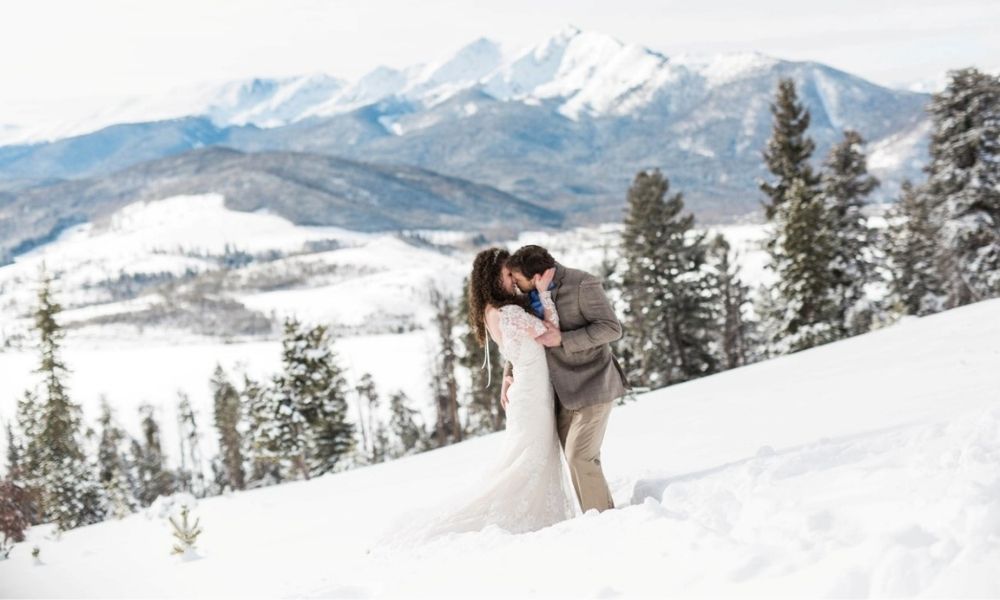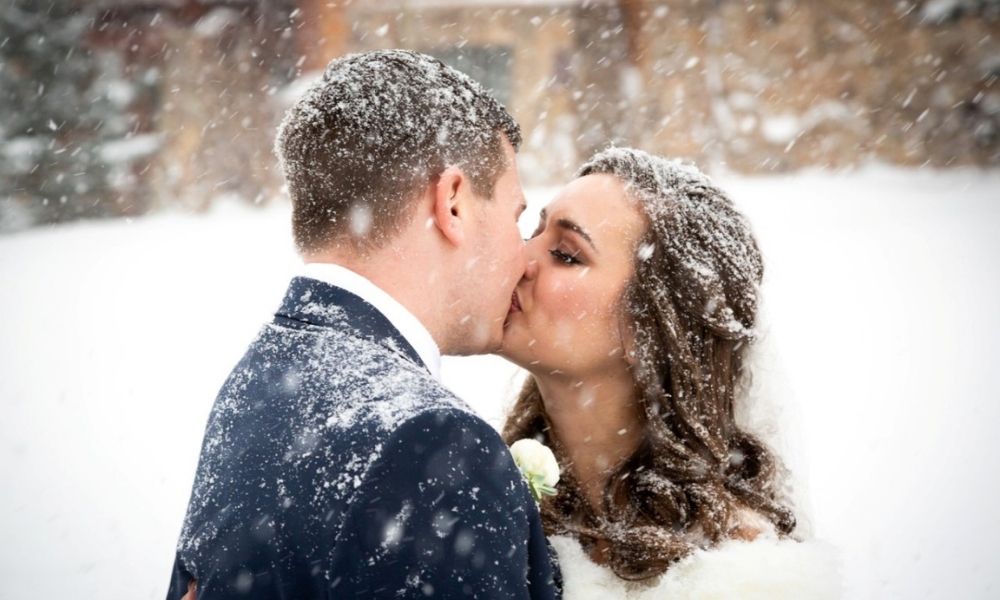Winter elopements in the snow can be stunningly beautiful. They’re also not for the faint of heart. I eloped in Colorado in December, and it was the most magical event ever! But I’m from New England and have a hearty tolerance for the white stuff. Eloping in winter might be a bit more challenging if you’re from… say… Georgia, and “cold” to you is anything below 60 degrees.

But if you’re up for a winter wonderland adventure and willing to be flexible, a winter elopement can be the perfect choice. Consider the advantages:
- Unless you decide to elope at a crazy-busy ski resort, most places will have fewer people around in winter. This gives you more privacy for your outdoor elopement.
- You get to wear really cute boots under your dress.
- The hem of a long white dress trailing along on the snow is stunning.
- After you’re married, you can snuggle up with each other in front of a fire in your cozy vacation cabin.
- If you time it right and get married from the end of November through the beginning of January, you can take advantage of existing holiday light displays for a fabulous photo backdrop.
- Winter in many places is a slow season for wedding vendors, so you may get discounted pricing.
- Because the sun is lower in the sky in winter, you’ll get fabulous, diffused light for photos.
- If you’re lucky enough to actually have it snow lightly during your elopement, your photos will be beyond spectacular.
- You can turn your winter elopement into an adventure elopement and snowshoe or snowmobile to a remote destination if you’re super adventurous.

Winter elopements require a different level of planning than summer ones. The unpredictability of winter weather requires you to be flexible. In planning your winter elopement, consider the following:
- Roads may be closed due to winter storms. If you’re planning a destination winter elopement, expect to be in town long enough to push off the wedding by a day or two if need be. Check with your vendors before you sign their contract to make sure they can be flexible in the event of inclement weather.
- If you’re not comfortable driving in the snow, hire an experienced driver to chauffeur you around. It’ll save a ton of stress—and keep you safe. If you do decide to drive, make sure the vehicle has four-wheel drive and good tires.
- Winter elopements are best for couples who don’t have any guests (or at most, just a handful). Making a last-minute change when it’s just the two of you is one thing. But trying to come up with a Plan B when you have 40 guests and decide to move your wedding indoors is no fun.
- The key to a successful winter elopement is dressing for the conditions. Dress in layers. For brides: tights under your dress with warm boots on your feet. (Winter weddings are not the occasion for your five-inch open-toed stilettos!). Pick up a gorgeous wrap or cape. You can take it off for short periods of time to get breathtaking photos of you in your dress, and then quickly put it back on to warm up if you get cold. Grooms also need to wear warm boots (with a decent tread so you don’t go slipping and sliding all over the place) and a coat or jacket.
- Choose your winter elopement venue wisely. Avoid large bodies of water—coastal sites and locations close to large lakes can be windy in winter. Your wedding planner or photographer should be able to help you in choosing a venue.
- Speaking of your wedding vendors, be sure you book locally based wedding vendors. If your photographer has to travel a couple of hours to get to your site and there’s a road closure or blizzard, you’re going to be in trouble. Likewise, book a planner who specializes in winter elopements and who is based in the area where you want to marry. Then, take advantage of their expertise when it comes to planning the day.
- One more word about vendors: be sure your photographer is experienced in shooting in the snow. Winter photoshoots require an entirely different skill set from summer photography.
- Book lodgings that can serve as an indoor ceremony venue if the weather gets really bad. Something with an eye-catching fireplace or a picture window view of the woods or the mountains is a good idea. You may be up for getting some post-ceremony photos outside in the snow, but may decide to exchange your vows inside where it’s toasty before venturing out into the elements. A vacation rental is a better lodging choice for a winter elopement than a standard hotel room.
- Another bonus of staying in a vacation rental is that you don’t have to travel to get from your lodging to your ceremony site if the grounds are pretty enough for an elopement. You might consider hiring a personal chef to come in and prepare your celebratory dinner and you won’t have to drive anywhere on your wedding day! Let it snow!
- Don’t overschedule your outdoor wedding photography. What feels exciting and exhilarating for the first ninety minutes might start to feel cold, wet, and yucky after being outside for longer than that—especially if you’re unaccustomed to colder temps. Alternate your outdoor wedding adventures with some intimate indoor photos of you cutting into a small cake for two and toasting each other with champagne as you sign your marriage license. You don’t have to spend the entire day outdoors.
The bottom line for a successful winter elopement is to be willing to go with the flow, plan for all weather scenarios, dress warmly, and hire wedding professionals that are familiar with winter conditions. Do all of that, and you’ll truly be in for a winter wonderland small wedding experience.



